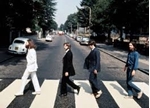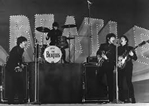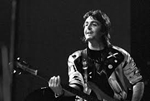- Register
- Log in to Tune-In
- Wishlist (0)
-
Shopping cart
(0)
You have no items in your shopping cart.
Beatles News

Software entrepreneur and music producer Scott Freiman put together a little show for friends in his living room in Irvington, New York, back in 2009, listening to some Beatles music. He’d been a fan of their work since childhood and enjoyed analyzing what made it so unique.
Before he was finished, his friends — composers and producers — were suggesting he was on to something. They told him he ought to develop his ideas into presentations others could enjoy as well. His background was perfect: an undergrad degree from Yale in computer science and music, and a master’s from New York University in music composition. He’d been in the business full time since 2001, opening his own studio in 2005, writing film scores, editing movie sound and music, and selling out Carnegie Hall with a concert of original music for orchestra and children’s choir.
Source: Joe Stinnett/newsadvance.com
details
That December day in 1971 when John Lennon came to Ann Arbor was his own idea…he wasn’t invited, but took it upon himself to come and perform.
The reason? John had heard about the plight of John Sinclair. Sinclair was chairman of the Rainbow People’s Party of Ann Arbor and was serving an unjust ten years in Jackson State Prison for possession of two marijuana joints. The People’s Party did their best to bring attention to their cause by holding concerts, benefits, and rallies, and they even got a handful of celebrities involved, like actor Donald Sutherland, Jane Fonda, and others. After Yippie activist Jerry Rubin told Lennon about an upcoming December 10 rally for Sinclair, Lennon took the ball and ran. He wrote a song about Sinclair that can be found on his Sometime in New York City album.
The rally was to be held at UM’s Crisler Arena, and Lennon said he would donate his performance fee to the John Sinclair Freedom Fund.
Source: 99wfmk.com
details
James Taylor is one of the most iconic folk singers of the 1960s, which is saying a lot. Although the Beatles occasionally dabbled in folk music, they largely stayed in a separate musical lane from Taylor. However, that doesn’t mean he didn’t socially interact with the Beatles now and then.
In fact, Taylor auditioned for the Beatles. Later, Taylor had a front-row seat to the later years of the Beatles. Surprisingly, he admitted to being a bad influence on the group.
Rolling Stone reports Taylor was signed to the Beatles’ Apple Records in 1968. He was able to secure an audition for the label after his friend gave his demo tape to Apple’s head of A&R, Peter Asher. On a 2015 episode of Late Night with Seth Meyers, Taylor said scoring the audition was a great example of “being in the right place at the right time.”
Taylor was told he was going to audition for two Beatles an hour before the audition was going to happen. He recalled auditioning for Paul McCartney and George Harrison and being thoroughly intimidated by the experience, as most musicians would be. At the audition, he played “Something in the Way She Moves,” which was his favorite of the songs he details

Just days before his death, The Beatles founding member George Harrison wrote a letter to Austin Powers director Mike Myers expressing his admiration for his work.
The letter, which would go on record as the final note ever written by ‘The Quiet Beatle’, was never mailed out to Myers but was subsequently passed on to the filmmaker who, coincidentally, ended up receiving on the day Harrison passed away.
Myers, whose father was born in Liverpool, once said: “You don’t know what The Beatles were in my house,” in an interview with WENN news. “They were everything. Liverpool was poorish and it was rough and all of a sudden it was cool to come from this town, so my parents were eternally grateful.”
Later, in a wide-ranging interview with GQ, Myers was asked: ‘Is it really true that the very last letter George Harrison wrote in his life was to you?’ and, remarkably, it was: “Yes. That’s mind-blowing, dude, for the son of a Liverpudlian, a person who worships the Beatles,” Myers replied.
Source: faroutmagazine.co.uk

The National Trust is looking for a guide to work at the childhood homes of Paul McCartney and John Lennon.
The "once in a lifetime opportunity" has become available due to a long-serving member of staff retiring.
The Beatles composed and rehearsed many of their early hits at the houses in Liverpool.
The charity said it wanted someone with "accurate historical knowledge" to bring the "early years of two of the Beatles' story to life".
Paul McCartney lived at 20 Forthlin in Allerton from the age of 13 to 22 and about 100 Beatles songs were composed there.
Lennon lived at Mendips, a 1930s semi-detached house in Woolton, with his Aunt Mimi from the age of five to 22.
Source: bbc.com
details
If you were looking for experimental music from The Beatles, you’d probably look to John Lennon first. After all, Lennon was behind the sound collage that was “Revolution 9” and another wild song the band rejected during the White Album (1968) sessions.
But Paul McCartney had gotten out in front of John in this regard. When Paul led the band through the free-form “Carnival of Light” in ’67, he’d long been experimenting with avant-garde music. (According to Ian MacDonald, Paul worked on tape loops and musique concrete as early as ’65.)
By the time The Beatles got near the end of the line, Paul felt ready to bring “prepared piano” to a Fab Four track. In this case, it involved altering strings to get a metallic effect. When George Harrison asked for a different piano sound on “For You Blue,” Paul got to work.
Source: Cheatsheet
details
The Beatles: Paul McCartney says John Lennon split the group
John Lennon and Paul McCartney were incredible songwriters and their joint powers created some of the best songs in the world. But they also had some pretty nasty things to say about each other, which they certainly didn’t shy from in their songs. But what happened between the pair of them, and did they patch things up?
John Lennon and Paul McCartney wrote many of the Beatles biggest hits together.
Lennon and McCartney met at a local church fete in 1957, where Lennon was performing with a skiffle group called the Quarrymen.
After Macca impressed Lennon with his guitar stylings, he was invited to join the Quarrymen, and soon they brought along their friends to listen to their new song performances, inviting mates such as Nigel Walley and future Beatle George Harrison.
Source: Jenny Desborough/express.co.uk

Between summer 1968 and January ’69, relations between The Beatles hit an all-time low. During the making of the White Album, Ringo Starr registered his personal disgust with the situation by walking out on the band for a few weeks (in August ’68).
That left the group without a drummer, which led the remaining three to try their hand at the kit on “Back in the U.S.S.R.” Though Ringo returned before long, that set a precedent. Later in the White Album sessions, Paul McCartney played drums on “Mother Nature’s Son” even though Ringo was in the studio that day.
The following year, Paul was back on drums for a May ’69 single. On the A-side, listeners heard “The Ballad of John and Yoko,” John Lennon’s No. 1 hit. For its B-side, fans got the George Harrison track, “Old Brown Shoe.” In this case, Paul played drums on both because Ringo was on a film shoot.
Source: cheatsheet.com
details
On his first trip to England in 1968, James Taylor played for Paul McCartney and George Harrison. The younger half of the Beatles were impressed with the Chapel Hill-raised singer-songwriter, and they made Taylor the first act signed to the nascent Apple Records. Taylor began recording his debut album at Trident Studios, where the Beatles were also recording The Beatles at the time.
“We intersected in the studio a lot,” says Taylor in a new interview in the Guardian. “They were leaving as I was coming in. I often came in early and would sit in the control room and listen to them recording – and hear playbacks of what they had just cut.”
It’s hard to imagine what more a barely 20-year-old musician could want, but it wasn’t all good news for Taylor. He quickly picked up a drug habit in London, where heroin and other opiates were cheap and easy to find at the time.
“[Y]ou used to be able to buy something called Collis Browne’s Chlorodyne, which was an old-fashioned medication. Essentially, it was a tincture of opium, so you’d drink a couple of bottles and you could take the edge off,” he recalled. Eventually, he shared his stash with none oth details

In 1961, The Shirelles made history when “Will You Love Me Tomorrow” topped the Billboard Hot 100. It was the first time a black girl-group — any girl-group, some say — ever hit No. 1 on the leading U.S. pop chart.
When record-buyers took that single home, they found another gem on the B-side. That was “Boys,” a track Luther Dixon and Wes Farrell had written for the group of young ladies from New Jersey. Over in England, a Liverpool band called The Beatles started performing it live in their performances.
Though this early version of The Beatles featured John Lennon, Paul McCartney, and George Harrison, the vocal duties on “Boys” went to drummer Pete Best. Across town, playing for Rory Storm and The Hurricanes, drummer Ringo Starr also sang the song.
So when Ringo joined The Beatles in ’62, he kept running with the vocal whenever the band played “Boys.” And it never seemed to matter that the lyrics spoke of “boys — what a bundle of joy.”
Source: cheatsheet.com

Ever since the Beatles broke up, fans wished they would reunite. That sort of happened in the years following John Lennon’s death. Here’s how an unfinished demo by John led to a musical reunion for the Beatles.
Ultimate Classic Rock reported that, in 1977, John recorded a demo song called “Free as a Bird” for the musical The Ballad of John and Yoko. He never finished it and he died in 1980. According to The Beatles Bible, George Harrison approached Yoko Ono to see if he and the other surviving Beatles could work on some of John’s demos together. In 1994, Yoko would give Paul McCartney tapes containing four unreleased John tracks: “Free as a Bird,” “Grow Old with Me,” “Real Love,” and “Now and Then.”
Paul was moved listening to them. He said “I’d never heard them before but she explained that they’re quite well known to Lennon fans as bootlegs. I said to Yoko, ‘Don’t impose too many conditions on us, it’s really difficult to do this, spiritually.’”
Source: cheatsheet.com

The song "I Want to Hold Your Hand" is so incredibly simple lyrically. But when The Beatles released this song and showed how they could take a song about two lovers holding hands and make it into something special, the world definitely listened.
The upbeat music and beats mixed with a fun and energetic chorus were extremely contagious, and had fans everywhere singing along. This was only emphasized by when they performed the song live on The Ed Sullivan Show in 1964.
One of the most popular song written and sang by John Lennon was "Norwegian Wood" on the album Rubber Soul. This song had an almost folk-like sound to it all while telling a very intriguing story about John Lennon visiting a friend of his and staying the night.
Source: Alex Parisi/theblast.com
details
When The Beatles bought the possibility carry out on the 1967 Our World broadcast, they weren’t significantly excited. Despite the very fact it might attain a whole bunch of tens of millions internationally, John Lennon waited till simply earlier than the occasion to write down the tune they’d carry out.
But John got here up with a winner (“All You Need Is Love”), and to make issues extra fascinating he determined he’d sing it stay for the June ’67 broadcast. That gave the Beatles’ manufacturing crew nervous suits.
After John determined he’d sing stay, Paul McCartney mentioned he’d do the identical together with
his bass half. Once Paul was in, they turned to George Harrison to see if he’d play the guitar solo stay as properly. George agreed.
Source: Jeremy Spirogis/sahiwal.tv
details
If you wanted obscure lyrics, the 1967 work of John Lennon will do. Start with the “looking-glass ties” and “marmalade skies” on “Lucy in the Sky With Diamonds.” As John said of a different Beatles song from that year, “Stick a few images together, thread them together, and you call it poetry.”
He was speaking about “I Am the Walrus,” a track that took obscure lyrics to another level. Yet on tracks like “All You Need Is Love,” his message couldn’t be clearer. A few years later, John was singing in the most direct way possible on “Don’t Let Me Down” and “I Want You.”
On his first solo album (1970), he dispensed with images entirely, and fans got more of the same on 1971’s Imagine. (“The only thing you done was ‘Yesterday,'” he sang of Paul McCartney.) But Mind Games (1973) found John back to writing at least somewhat obscurely.
Source: cheatsheet.com
details

In the autumn months of 1969, Paul McCartney died.
It had been a series of deaths, really. First up were the rumors, invented and spread by DJs and college students, that he had perished in a 1966, automobile accident and that the other Beatles were accomplices in the coverup. The Paul Is Dead hoax would be quelled after Life magazine dispatched a crew to Scotland to track down McCartney. The world breathed a sigh of relief after Life ran a November cover story under the banner headline "Paul Is Still with Us" and a glossy photo of the living, breathing Beatle with his young family.
But during that same period, he had also suffered a spiritual death of sorts with the Beatles' disbandment. For McCartney, the idea of no longer being in the group meant that his creative outlet had seemingly been extinguished. By his reasoning, the "overall feeling" during his downtrodden days in Scotland was that "it was good while I was in the Beatles, I was useful, and I could play bass for their songs, I could write songs for them to sing and for me to sing, and we could make records of them. But the minute I wasn't with the Beatles anymore, it became really very difficult."
Source: salon.com
